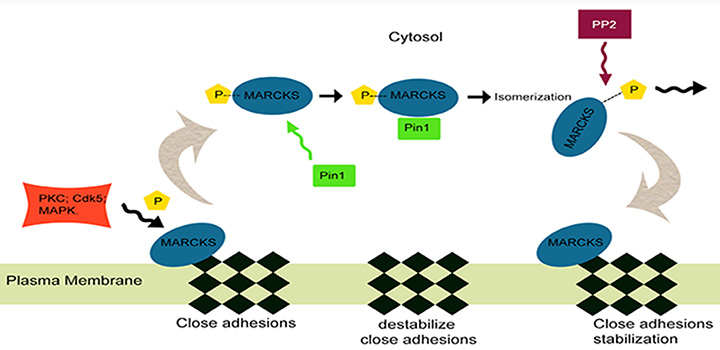Sosa LJ et al. 2016, J. Neurochem.
Axonal growth cone motility requires precise regulation of adhesion to navigate the complex environment of the nervous system and reach its target. Myristoylated alanine-rich C kinase substrate (MARCKS) protein is enriched in the developing brain and plays an important, phosphorylation-dependent role in the modulation of axonal growth cone adhesion. The ratio of phospho-MARCKS (MARCKS-P) to total MARCKS controls adhesion modulation and spreading of the axonal growth cone. Pin1, a peptidyl-prolyl cis/trans isomerase (PPIase) that recognizes and binds to phosphorylated serine/threonine residues preceded by a proline (pSer/Thr-Pro) is also expressed in the developing brain. Here, we show that Pin1 is present in the growth cone, interacts with MARCKS-P, and regulates its dephosphorylation. We also described morphological alterations in the corpus callosum and cerebral cortex fibers of the Pin1 knockout mouse brain that may be caused by the misregulation ofMARCKS-P and alterations of neuronal adhesion. We have shown that MARCKS, a critical protein in the movement of neuronal growth cones, is in turn regulated by both phosphorylation and cis-trans peptidyl isomerization mediated by Pin1. In the absence of Pin1, MARCKS is hyperphosphorylated, leading to loss of adhesions, and collapse of the growth cone. The Pin1 KO mice exhibited disturbed neuronal projections from the cerebral cortex and reduced white matter tracks such as the corpus callosum. This study highlights a novel function of Pin1 in neurodevelopment.
Authors: Sosa LJ, Malter JS, Hu J, Bustos Plonka F, Oksdath M, Nieto Guil OF, Quiroga S, Pfenninger KH
Article: Sosa LJ et al, J. Neurochem., 2016 Jun;137(5):744-55. doi: 10.1111/Jtrchkl36l2



